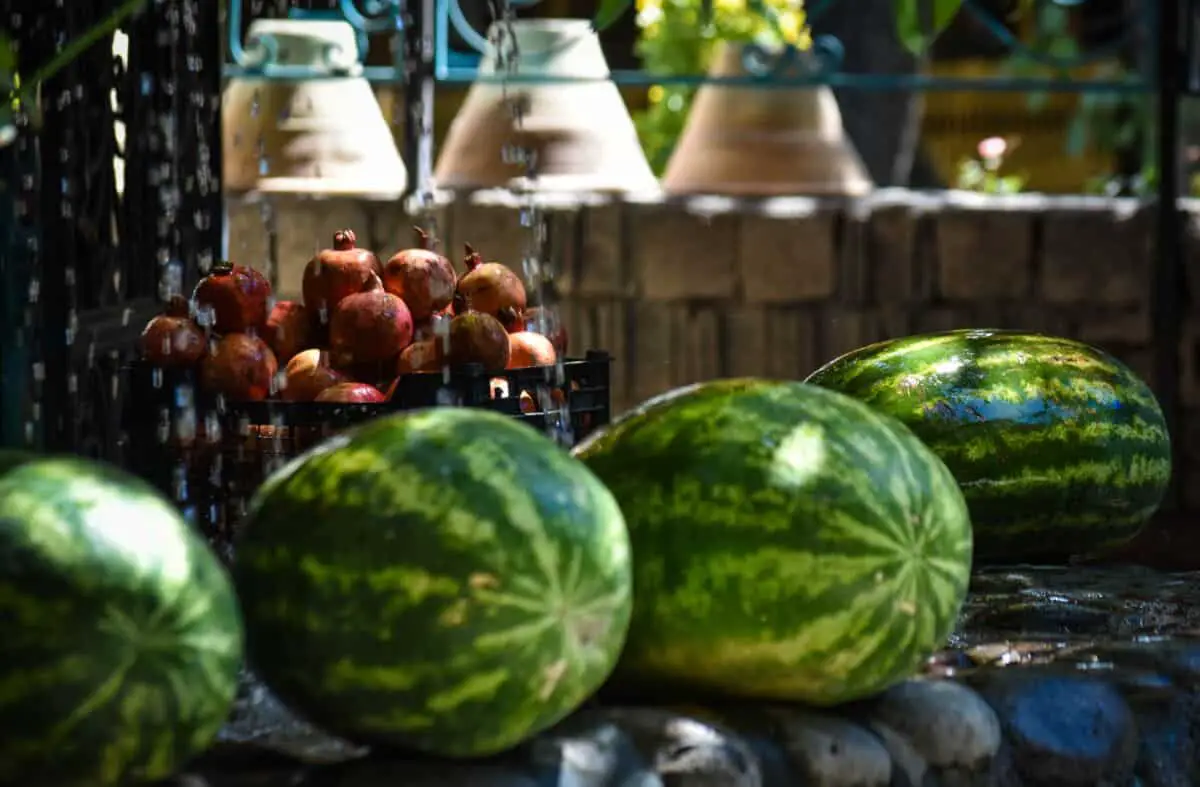Having watermelon juice or ice cream or simply eating cut cubes of watermelon is so refreshing, even more so if the watermelon is from your own backyard. Unfortunately, as the demand for housing grows, many houses have to make do with balcony gardening rather than having a full-fledged garden. Can watermelons be grown on a balcony?
You can grow watermelons on a balcony or any other smaller area by choosing the right size container, giving the plant plenty of water, and using a good quality potting soil with proper drainage. Also, by providing support to the plants as they start to grow heavier with the fruit.
Keep on reading to find out the various factors you need to be mindful of when you grow watermelons in a small space like a balcony.
Choosing the Right Pot for Your Watermelons
Watermelon plants, as they grow and bear fruits, will become heavier. Naturally, you will need to have a sturdy pot that can take that plant’s weight as it grows. The pot needs to be slightly large in width as well in order to accommodate the sprawling growth of the plant.
Watermelons tend to grow rapidly, reaching fruition within 90 days. During this time, they need plenty of water, and the soil needs to be constantly moist. For this, a large 5-gallon (19 kg) sized container will be required to accommodate the plant. Although, just having a large container will not be enough, and you will need one with enough drainage holes so that excess water can be drained off.
Watermelons have long taproots that will need a deep pot to grow in. When choosing the pot, look for one that is at least 2 ft (60cm) deep and at least half as wide. Make sure that you place pebbles and stones at the bottom of the pot to create a good drainage system. The loose rocks will allow water to pass through the pot.
Planting the Watermelon Seeds
Spring is the best time to start planting watermelon seeds. When the temperatures have begun to warm up after the winters, you can start by sowing a couple of seeds directly into the pot.
There are a lot of varieties you can choose from:
- Moon and stars watermelon
- Sugar baby watermelon
- Crimson sweet watermelon
- Early moonbeam watermelon
- Jubilee watermelon
- Golden midget watermelon
- Jade star watermelon
- Millennium watermelon
- Orange watermelon
- Solitaire watermelon
It will take around 5-10 days for the seeds to germinate. Once they begin to germinate, thin out the pot by removing the shorter seedlings and keep the longest one in the pot.
Choosing the Right Soil for Your Watermelon Pot
Ideally, watermelons need to be planted in sandy and loamy soil with a pH balance of around 6.5 – 6.8. The soil also needs to be well-drained and airy so that there is no water retention. It further helps in promoting the growth of the plant.
You can fill the container with potting soil also, or use other soilless mixes by adding a variety of organic and inorganic material. Using these mixtures will allow you to grow your watermelon plants without making your plant prone to soil-borne diseases.
Once the planting is done, you will need to provide the necessary support as the plant grows. You can either build a trellis for the vines to creep up on, or even have a tepee in place to provide strength to the plant as it bears fruits.
Remember to Water the Plant Regularly
Irregular watering can cause stress and damage to the plant. Watermelons require plenty of water for their proper growth. So, you need to make sure that the pot is large enough to absorb enough of the water to sustain itself and has drainage to ensure there is no unnecessary water retention.
Keep the soil evenly moist at all times. On especially warm days, you may need to water twice a day. But once the fruits appear and it begins to grow, you can reduce the watering. But also remember not to underwater it as that will lead to stress in the plant.
Ideal Temperature
Watermelons like warm weather, and so they are mostly planted in tropical and temperate regions. In extremely cold places or places where there is a shorter summer, it is possible to grow them in greenhouses and inside the house and bring them out once summer starts.
They tend to grow well in temperatures of around 50-75°F (10-23°C), but the optimum temperature for their growth is slightly higher at around 65-85°F (18-30°C).
Proper Fertilizer
You can use liquid fertilizer to start fertilizing the soil in which you are growing your watermelon plant. Use ones with less nitrogen once the plant starts to flower and have fruits.
Liquid seaweed fertilizer can also help at this stage. You will need to provide the fertilizer once a week if you are using a water-based one. In case you are using a granulated fertilizer, you can space it out to once a month.
Having a lot of organic materials in your potting soil will also act as a fertilizer and will also help in keeping soil-related diseases at bay. They also improve the structure of the soil and increase its ability to hold water and nutrients.
Pruning Your Watermelon Plants
To ensure that your watermelon plant is healthy and prosperous, allow only the plant’s main vine to grow. This will ensure that the nutrients and water are all funneled to the main branch that will eventually bear the fruit. During this growth stage, keep removing any side branches meticulously. In case you spot any diseased or damaged stems remove them as well.
The Fiskas Steel Bypass Pruning Shears is ideal for cutting stems and light branches. It also comes with a lifetime warranty.
Diseases and Pests
In extremely hot and humid climates or in harsh cold weather, these watermelon plants have been known to be prone to diseases and pests. Sometimes waterlogged soil can also be the cause of many diseases in the plant. Too much moisture or extreme dampness leads to an infestation of pests. Aphids and cucumber beetles are some commonly found pests in watermelon plants.
The cure to this is to ensure that there is no excess water in the plant that may affect the roots and to keep the plant’s pot clean and devoid of any pests by keeping the plant relatively dry instead of unnecessarily wet.
Time to Harvest
Within three months after sowing the seeds, the watermelon should be ready for harvesting. You will know that the watermelons are ripe for the picking by knocking on it. If you get a hollow sound, it is time to harvest the plant.
Another way to check for ripeness is by checking the tendril that sprouts from the top of the fruit. If the tendril has faded or is half dead, then the watermelon is ripe and ready for harvesting.
This video shows some more insider tips on how to grow watermelons in small spaces:
Conclusion
It is important to remember not to expose the watermelon to unnecessary stress by placing them in extremely harsh temperatures or allowing pests and diseases to proliferate, or watering them irregularly.
In places with shorter summers, you can start germinating the seeds indoors or by planting it in a greenhouse first. There will always be ways to enjoy a fresh watermelon, even if your garden is in a small space like a balcony.

